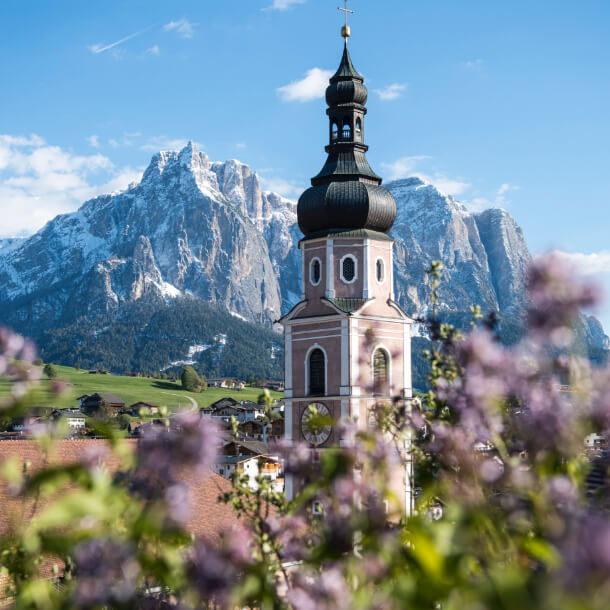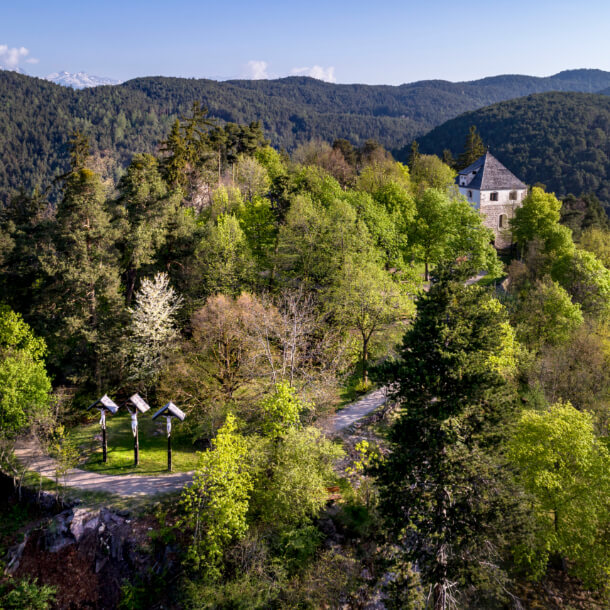Experience Castelrotto
Tips around Castelrotto
Welcome to the most beautiful days of your year in a truly unique location: Kastelruth at the foothill of the „Seiser Alm“
Our tips for your holiday:

Alpine hut „Marinzenalm“:
The charming alpine hut is located on the „Schlerngebiet“ plateau at 1,500 m. Here, the famous skiers Denise Karbon and Peter Fill have learnt skiing.
- more information
You can reach the alpine hut in just a few minutes with the chairlift from Kastelruth. You can take a break at the hut „Marinzerhütte“ with its astonishing terrace or at the hut „Schafstallhütte“ (about 15 minutes on foot, passing the „Witches’ Benches“ rocks). Furthermore, in the area of Marinzen you can find a petting zoo for the little ones, a children’s playground and a fish pond where you can go fishing. You can go on lovely hikes starting from the alpine hut „Marinzenalm“.
More information about alpine hut “Marinzenalm”

Traditional costume museum
In the traditional costume museum in the historical residence Lächler at the village centre of Castelrotto, you will find many historical costumes and their accessories from the 18th, 19th and 20th century. There is also a collection of historical photographs.

„Kastelruther Spatzen“ Museum:
You can find out everything you wanted to know about the famous music group „Kastelruther Spatzen“ at this museum. There is also the fan shop at the museum.
- Opening hours
Monday – Friday:
from 9 a.m. to noon and from 2 to 6 p.m.Saturday:
from 9 a.m. to noon

Church steeple of Kastelruth
With its height of 82 m or rather 298 steps the church steeple of Kastelruth is the third highest in all of South Tyrol. It is also said that the bells have the most beautiful peal.
Just book a guided visit of the church steeple — each Thursday at 5 p.m.

Castellum ruptum
Discover the village of Kastelruth. The remains of the castle walls of Catellum ruptum can be found near the chapel at the „Kofel“ mountain.
More about the history of Castelrotto

The way to the "Kofel"
Take the narrow entrance to the path up to the Kofel hill and to the left you will see the rear of the Krausegg residence with its substantial late Gothic oriel windows
- more information
The building that now houses the Turmwirtshaus appears in a document dated 1511, where it is called the ‘Haus in der Schmalzgruben’. Soon after 1511 it was acquired by the Kraus von Sala family and it accommodated the local law court for more than 150 years. To the left is the picturesque Steinerhaus, the last surviving farmhouse in the village centre.

The Kofel hill
The hill top, where a leisure park is also located, invites visitors to pause, catch their breath after the climb and take in the magnificent views over the roofs of the village to the nearer and more distant surroundings.
- more information
On this spacious and breezy hill can be found seven Calvary chapels and the Emperor Franz Joseph Jubilee Fountain. Towards the end of the 17th century, the Kraus von Sala family had the ruined walls of the medieval castle that stood on this site demolished and constructed in its place a Calvary mount with seven chapels. The only remaining relic of the castle that gives some idea of its former grandeur is one of its towers, the Burggrafenturm, which has been converted to a double chapel. To mark the 60th anniversary in 1908 of the ascent of the Emperor Franz Joseph I to the throne of the Austro-Hungarian Empire, the citizens of Kastelruth built the Jubilee Fountain in a central spot and commissioned Eduard Burgauner to decorate it. For political reasons after the First World War, the portrait of the Emperor was painted over and thus covered up, but it was restored during the most recent renovation of the fountain. At the same time as the fountain was built, the whole of the hill top was converted to a leisure area with benches and pathways.

Seiser Alm
The „Seiser Alm“ is the largest high altitude alpine pasture in Europe with its 56 square kilometer. The impressive scenery covers a surface area equal to as 8,000 soccer fields and is part of the Dolomites, a mountain range classified as a UNESCO World Natural Heritage.

Pflegerhof farm
The farm „Pflegerhof“ is nothing but a paradise of colors and scents. Since 1982 they’ve been growing about 500 species of 80 different sorts of medical- and spice plants. The farmers work with love and expertise in the garden situated at 800 m and covering a surface area of 17 hectare.
- Opening hours
The farm shop is open from Monday to Saturday. The shop is closed on Sundays and on holidays. Guided tours are possible from May until October.

The Geologist’s path
A nature experience: This path lets you experience the history of the earth and it is considered the most geologically interesting of its kind in the Dolomites. 10 different information boards along the path will show you the different rock formations.

Castle „Trostburg“
The history of the castle „Trostburg“ dates back to the 12th century. Visitors can discover ancient Roman arch windows and doors as well as Gothic fortifications.
- more information
Experience the times of the minstrel Oswald von Wolkenstein and the late Gothic style of home furnishing of the 15th and early 16th century, or marvel at the magnificent halls and panelling from the 16th and 17th century as well as cornices and furnishing of the Renaissance.
Opening hours: from Maundy Thursday until the end of October.
Details about the Castle „Trostburg”

Hike with witch Martha
Go on a hike with witch Martha to find mysterious places at the Seiser Alm.
- more information
Immerse yourselves in the bygone era at the castel „Prösels“, prepare a special witch-meal and experience a ghostly night-hike. You’re sure to find your inner witch or wizard during this enchanting program! Magical experience ideal for adults and children!
To the witch-program

Puflatsch
From the alpine hut „Marinzenalm“ you will hike uphill to „Puflatsch“ and to the „Seiser Alm“. This path is quite exhausting but the astonishing view and the „Witches’ Benches“ rocks are definitely worth it

Farmer’s museum
At the „Tschötscherhof“ farm, dating back to the 15th century, Michl Jaider collects old equipment for the farmers’ museum: harrows, ploughs, threshing machines, rakes, even a windmill — and much more.
- Opening hours
from 1st March to 30th November from Thursday to Tuesday from 9 a.m. to 8 p.m.

School museum and Shoemaker’s workshop of Tagusens
School — how it was back then and how it is today.
- Opening hours
from Easter – All Saints’ Day, Wednesdays and Fridays from 2 p.m. to 6 p.m. and Sunday from 10 a.m. to 6 p.m.

Christmas Market of Kastelruth
The Christmas Market of Kastelruth offers culinary specialties from farmers and restaurateurs as well as handicrafts from farmers and tradesmen in an idyllic atmosphere.
- Opening hours
every weekend in Dezember — from Friday to Sunday.

